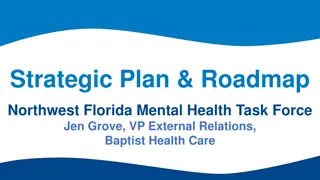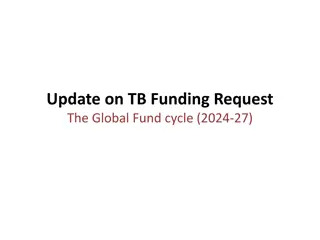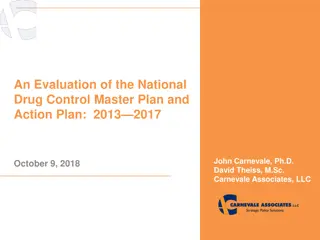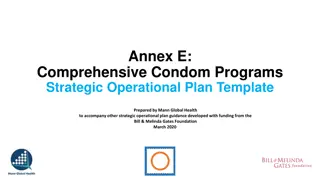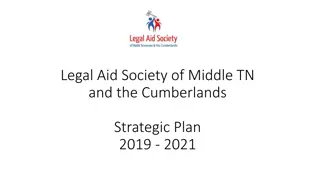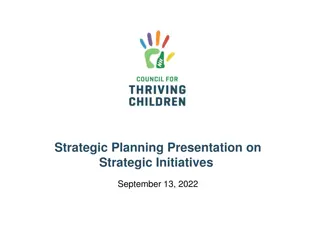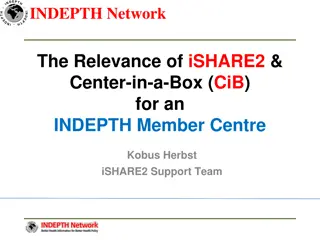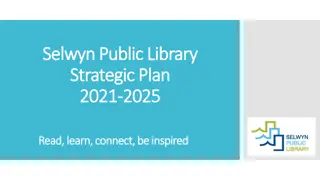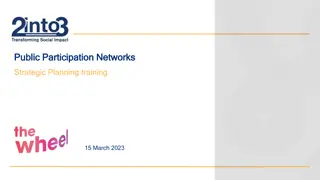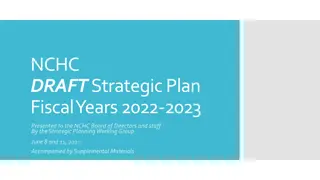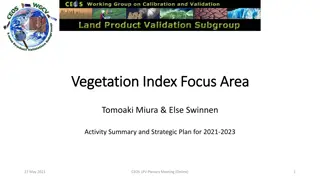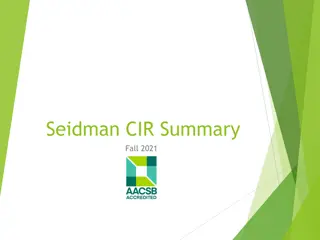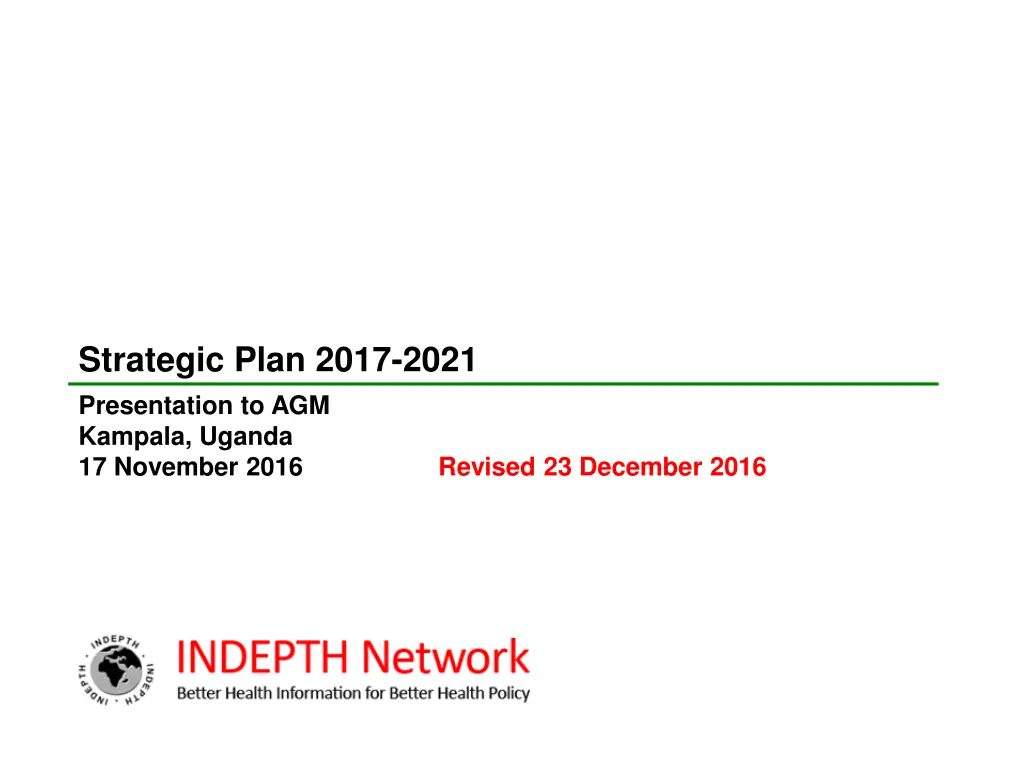
INDEPTH Network Strategic Plan 2017-2021 Presentation Highlights
Explore the strategic plan presented to the AGM in Kampala, Uganda, detailing INDEPTH Network's vision, mission, value proposition, competitive advantage, key strategic objectives, and tactics to enhance capabilities, conduct research, enrich policy, strengthen partnerships, and promote the value of population-based longitudinal data.
Download Presentation

Please find below an Image/Link to download the presentation.
The content on the website is provided AS IS for your information and personal use only. It may not be sold, licensed, or shared on other websites without obtaining consent from the author. If you encounter any issues during the download, it is possible that the publisher has removed the file from their server.
You are allowed to download the files provided on this website for personal or commercial use, subject to the condition that they are used lawfully. All files are the property of their respective owners.
The content on the website is provided AS IS for your information and personal use only. It may not be sold, licensed, or shared on other websites without obtaining consent from the author.
E N D
Presentation Transcript
Strategic Plan 2017-2021 Presentation to AGM Kampala, Uganda 17 November 2016 Revised 23 December 2016
INDEPTH Vision & Mission: Vision: To be a trusted source for evidence supporting and evaluating progress towards health and development goals. Mission: To lead a coordinated approach by the world s health and demographic surveillance systems to provide timely longitudinal evidence across the range of transitioning settings to understand and improve population health and development policy and practice.
INDEPTH Value Proposition: INDEPTH's on-going longitudinal health and demographic tracking across the... network of independent population-based Centres operating in different systems and cultures enable our scientists and scientific partners to offer a unique vehicle for the study of the impact of policy and practiceand the development and validation of effective interventions.
Competitive Advantage 1. A unique network of independent HDSS centres Conducting longitudinal population-based tracking Comparing data across different systems and cultures Leveraging the collective value of data across sites 2. A high-quality research capacity for multi-site studies using longitudinal, population-based tracking. 3. Linking member centres with health and other policy-makers to magnify research findings and enable evidence-based decisions. Well positioned to support stakeholders focused on leveraging accurate data and assessing key SDGs 4. Strengthening the community of scientists by harnessing expertise, improving training, enhancing career paths, and sharing data
Key Strategic Objectives 1. Enhance the INDEPTH Network's capabilities: Invest to improve and expand the underlying longitudinal, population-based tracking platform Continue to ensure ethically sound research sensitive to local circumstances 2. Conduct multi-centre research, leveraging longitudinal tracking 3. Enrich & guide policy: linked to SDGs and using our accurate data Address neglected issues and the impact of social inequality 4. Strengthen capacity of INDEPTH member centres and researchers 5. Build effective partnerships with key national/int l partners Governments: statistics offices, local government, health and development ministries and agencies, Research and educational institutions International policy bodies (WHO, UN)
Key Tactics 1. Promote importance & value of population-based longitudinal data Improve messaging & evidence for scientific/policy communities. 2. Deepen the scope of monitoring across all member centres 3. Develop new partnerships With LMIC governments, agencies and universities to support population-based data operations Ensure balanced/effective relationships with HIC* institutions 4. Expand the extent of cross-network coordination 5. Produce a regularly-updated set of INDEPTH-wide products Leverage the full array of HDSS research, intervention, evaluation, and surveillance initiatives. * High Income Countries
Setting Scientific Research Priorities INDEPTH uses population-based, longitudinal data as the lens to identify areas where the Network has a clear advantage in research Over 25 specific research topics identified I. Improve and maximise the value of the core research platform 1. Implement CHESS and other enhancements to improve population tracking 2. Provide timely metrics based on real population-based data II. Leverage that platform to study key scientific questions that benefit most from longitudinal data 3. Conduct studies across the life-course 4. Research key policy, practice and demographic questions 5. Assess scientific- and policy-relevant determinants & context of outcomes
Maximise the Value of the Platform 1. Implement CHESS and Other Enhancements to Improve Population Tracking Across Sites 1. Streamline the data collection process (openHDS) 2. Deepen tracking to enumerate additional metrics (CHESS) 3. Improve the Verbal/Social Autopsy process Upgrade to WHO-2016 across INDEPTH; integrate with social autopsy Ensure at least annual updates Provide mortality input into estimates of burden of disease 4. Strengthen links with Health Systems Develop a Health System Advisory Council for the Centre Work with local health authorities to help raise funds for the Centre Identify relationships between the health system and the local Centre 5. Create ties with CRVS systems Monitor the effectiveness of CRVS improve CRVS implementation. Use data to assess progress of country to achieving the SDGs
Maximise the Value of the Platform 2. Provide Timely Metrics Based on Real Population-Based Data 1. Create regular updates on Mortality across the array of systems and cultures in which our Centres operate 2. Expand to report on Morbidity, Burden of Disease, Diagnostics and Demographics The Network will make this information available on INDEPTH-Stats and publish findings in key journals In addition to addressing key scientific questions, it will help INDEPTH tighten links with policy makers across the LMICs and international/regional institutions.
Research Questions that Benefit from Longitudinal Analysis 3. Conduct Studies of Specific Life Stages 1. Fertility and Family Planning Develop standardized tools and approaches to capture, share and compare fertility / FP data across member centres. 2. Maternal, New-born, Child Health and Vaccination/Immunization Impact of health systems interventions on maternal, new-born, infant and child health, including stillbirths Testing/validation of interventions, protocols and indicators 3. Adolescence Healthy Transitions Marketing health and social services to local adolescents Ensuring access to health facilities for adolescents 4. Adult Health & Ageing Increase focus on non-communicable diseases Expand to include the wider network
Research Questions that Benefit from Longitudinal Analysis 4. Research Key Policy, Practice and Demographic Questions 1. SDG baselines & dynamics Map key SDGs to data centres collect (will collect with CHESS) Assess progress towards specific SDGs 2. Product safety effectiveness, resistance, and quality Introducing inter-operable electronic health records systems Incorporating PV into CHESS Collaborating with EDCTP/AMRH 3. Health Interventions Identification/Assessment Work with agencies focused on interventions Sharing the results with other geographies 4. Migrant health tracking The role of education as a determinant of internal migration The impact of migration on cause of death The impact of migration on infectious disease morbidity 11
Role of HDSS in Tracking Health-Related SDGs HDSS Value +++ +++ +++ +++ ++ ++ ++ ++ + + ++ + +++ Health-Related SDG (SDG 3) 3.1 Maternal mortality 3.2 Infant/Neonatal mortality 3.3 Infectious/communicable diseases 3.4 Non-communicable diseases 3.5 Substance abuse 3.6 Road/traffic accidents 3.7 Universal access to sexual and reproductive health-care services 3.8 Achieve universal health coverage 3.9 Hazardous chemicals/air, water and soil pollution 3.a Tobacco Control 3.b R&D of vaccines and medicines 3.c Health workforce in developing countries 3.d Early warning and management of national and global health risks 12
Partial Role of HDSS in Many non-Health SDGs HDSS Value HDSS Value SDGs SDGs 1. End poverty ++ 10. Reduce inequality 11. Make cities inclusive, safe and sustainable 12. Ensure sustainable consumption 2. Achieve food security + ++ 3. Ensure healthy lives +++ ++ 4. Ensure equitable quality education ++ 13. Combat climate change 5. Achieve gender equality + 14. Sustainably use the oceans 6. Ensure sustainable management of water + 15. Protect ecosystems, + 16. Promote inclusive societies 17. Revitalize partnerships for sustainable development 7. Ensure access to energy + + 8. Promote sustainable economic growth 9. Build resilient infrastructure 13
Research Questions that Benefit from Longitudinal Analysis 5. Assess Scientific- and Policy-Relevant Determinants & Context of Outcomes - I 1. Environment, Climate and Indoor Air Pollution Estimating the actual impact on health of particular weather events; Contributing to context-specific and appropriate adaptation strategies and policies. 2. Health Equity and Poverty INTREC (INDEPTH Training and Research Centres of Excellence) was established with this concern in mind Expand to provide essential info on impact of poverty on health equity 3. Vaccines INDEPTH HDSS Centres are in unique position to examine the effects of vaccines because of longitudinal tracking as well as our experience in Phamaco-Vigilence (PV) 4. Genetic Factors in Health The AWI-GEN Collaborative Centre with Wits University
Research Questions that Benefit from Longitudinal Analysis 5. Assess Scientific- and Policy-Relevant Determinants & Context of Outcomes - II 5. Sex differentials/gender In all publications and in tracking all INDEPTH s own work the Network and member scientists will look to provide information disaggregated by sex. In addition, it is setting up a Working Group devoted specifically for monitoring and assessing the impact of gender on interventions and outcomes as well as steps to empower women and girls. 6. Education-based Analysis and Interventions Impact of food security & gender in education and outcomes. 7. Health system assessments With CHESS, it will be possible to track new information items, as well as determine the extent to which health system resources are aligned with the local burden of disease. The Secretariat will work with Centres to develop a methodology for linking with the local health system, 15
Policy Engagement and Communication INDEPTH will tailor, package and direct research outputs for different stakeholders to stimulate public appreciation of findings Reduce the critical gap between research findings and action. It will strengthen the ability to engage with stakeholders in an impactful way. Seeking an ongoing, iterative, dialogue with policy makers. Work closely and helping to strengthen role and capacity of HDSS Centres both at the national level or within the districts where they operate. It will seek to leverage engagement with policy makers to attract more funding for research-into-practice activities.
Policy Engagement: Key Tactics 1. Create a suite of branded products for all INDEPTH outputs. 2. Leverage forums, meetings and briefings with key stakeholders, 3. Increase participation in health policy events to build networks and engage in dialogue that INDEPTH research informs 4. Strengthen and collaborate with national and regional entities focused on population, health and development. 5. Use data visualisation tools to create health related infographics and interactive maps highlighting data emerging from HDSS centres. 6. Invite policy makers to actively participate in the biannual INDEPTH Scientific Conference 7. Increase the Network s media footprint
Capacity Strengthening and Career Development 1. Encourage all member centres to move from the traditional paper to electronic data capture -- and ensure the adoption of openHDS. 2. Ensure on-going support for the implementation of CHESS 3. Help centres strengthen and improve the dissemination, publication, and marketing of INDEPTH data analyses 4. Enable representativeness of the HDSS country level for CRVS 5. Expand the MSc programme and leverage the SDLP to train next generation of researchers and centre leaders Enable promising professionals from newer sites to spend time on ground at more established sites 6. Enable better Francophone-Lusophone-Anglophone collaboration 7. Support centres in establishing communication and training units 8. Enhance capacity for emerging topics and future research 9. Evaluate potential for an INDEPTH training centre
Ensuring Financial Sustainability While continuing its conservative and well-respected financial management, INDEPTH will focus on three paths to financial sustainability: 1. Continuing to look for both core and project support from funding partners, 2. Strengthening the efforts at building an INDEPTH consultancy that leverages the skills and advantage of the Network 3. Growing the endowment.
Resource & Training Centre Budget Focused on Coordinating Across Network 15,000 Budget of Resource & Training Centre represents about 10% of total cost of member centres HDSS operations/research Budgets of Independent HDSS Member Centres focused on HDSS Activities & Research 10,000 Annual ($K) 5,000 Cost of INDEPTH Resource Centre 0 Total Cost of Running INDEPTH 20
Costing the Strategic Plan Core Activities Contributed Centre Efforts Estimated Budget Managing the core HDSS operations ~10 M Secretariat Functions Core overhead: Admin, Finance, IT, Etc. ~$0.9 M Scientific Functions (Working Group support, Workshops, Management) Capacity strengthening $1.2 M $0.4 M Policy Engagement $0.3 M Governance & Fundraising $0.2 M Subtotal (Current Budget) ~$3.0 M Potential Additional Efforts from Strategic Plan Regular updates on Mortality (Annual) $0.5 M Expand to report on Morbidity, Burden of Disease, Diagnostics and Demographics (Annual, w/CHESS) Total: Potential Annual Costs for Core/Essential Activities $0.5 M ~$4M 21
Aspirations of the Strategic Plan: Envisioned Project Activities Cost (est) Cost(est) Project-based Efforts Project-based Efforts 4. Leveraging and Expanding the Utility of the Platform SDG baselines & dynamics Product safety Migrant health tracking 5. Assessing Determinants & Context: Nutrition, diet and food security Environment, Climate, Indoor Air Health, Equity and Poverty Genetic factors in Health 1. Deepening Longitudinal Platform Streamline data collection Deepen tracking (CHESS) Improving Verbal Autopsy process $1-2M $3-4M $1M $5M* $10-40M $5-10M Improve links with Health Systems $2M* Create ties with CRVS systems 2. Updating Metrics Regularly 3. Studying Specific Life Stages Fertility and Family Planning Pregnancy and Maternal & Child Health & Vaccinations $2M* (core) $1-2M $2-3M $5M $5M $1-5M $1-8M Education Analysis $1-3M Health system assessments, Health interventions Adolescence Health Transitions $1-5M $3-5M Adult Health & Aging $1-5M $49-114M TOTAL POTENTIAL PROJECTS 22
Addressing Potential Challenges To Strategic Plan INDEPTH may not find sufficient funding to maintain the network The Resource Centre will seek specific funding for on-going Network activities Capacity Strengthening, Policy Engagement, and the regular updates of Network products. Balancing interests between centres and network Ensure visibility for Centre participation in Network activities. Ensuring sufficient scientific leadership Insufficient coordination of network activities Ensuring investment in resources at Resource Centre & Working Groups to ensure sufficient time for leaders to work across Network. Low multi-site scientific productivity Loss of cohesiveness with growth
Objective 1: Enhance the Network's Capabilities: Sub-objective Metrics 1. Roll out openHDS to 80% of all INDEPTH member Sites in 2017 2. Finish design for CHESS and pilot in 2 member Sites in 2017 3. Roll-out CHESS to 50% of all INDEPTH member Sites over course of plan 4. Roll-out WHO-2016 across member sites in 2017 # of Sites w/openHDS in process # of Sites fully on openHDS Availability of results of CHESS pilot # of Sites w/CHESS in process # of Sites fully on CHESS Status of WHO-2016 # of Sites using WHO-2016 # of Sites with clear linkage to national CRVS 5. Get 5 Centres to develop links with their country s CRVS systems in first year
Objective 2: Conduct cutting-edge research, leveraging its longitudinal tracking: Sub-objective Metrics # of operating Working Groups # of Working Groups providing repots in past 12 months # of submitted proposals # of funded studies # of multicentre grants $ of multicentre grants # of multicentre publications 1. Increase the activity level of Working Groups and have 5 new active Working Groups by 2017 2. Increase the number/Quality of multicentre proposals by an additional 10% by 2017 3. Increase the number of multicentre grants and consultancies by 10% by 2017 4. Increase the number of multicentre publications by 10% by 2017 5. Publish annual update of core HDSS metrics across INDEPTH sites in 2017 6. Publish update of VA results for 2016 in 2017 # of sites participating in multicentre core publication # of VA results completed 7. Develop initial baseline for CHESS results in 2017 Availability of baseline CHESS results # of Sites with baseline SDG results 8. Develop/publish baseline SDG results in 2017
Objective 3: Enrich & Guide Policy That Is Community Responsive & Linked To The SDGs: Sub-objective Metrics 1. Increase the number of Systematic Reviews by 10% in 2017 2. Increase the number/Quality of Policy Briefs (Secretariat, centres) by 10% by 2017 # of Systematic Reviews published # of Policy Briefs completed Qualitative review of impact of Policy Briefs # of presentations to policy stakeholders, by Centre, by Secretariat List of recommended changes Impact of recommended changes in policy and practice # of policy makers attending ISC and other INDEPTH meetings 3. Increase the number of Stakeholder interactions (national, regional and int ) by 10% by 2017 4. Increase Policy/Practice influence and the number of recommended changes linked to INDEPTH findings by 10% by 2017 5. Double the number of policy makers who attend INDEPTH convened meetings in 2018, including 2018 ISC 6. Get 5 additional Centres to formalize links with their country s Ministry of Health # of Centres with formal links to Ministries of Health
Objective 4: Strengthen Capacity of Centres Sub-objective Metrics 1. Train 10% more scientists and HDSS staff by 2017 and improve the skills of existing ones 2. Improve data harmonisation and management across the network 3. Get 10 more Centres (and their Sites) to move to non-paper based data capture by first year 4. Increase the number/Improve quality of publications using INDEPTH member data by 10% by 2017 # of Scientists participating in Capacity Strengthening initiatives # of Sites on iShare Error rates # of Centres using non-paper based data capture # of publications that use member data
Objective 5: Build Effective Partnerships: Sub-objective Metrics 1. Increase number of partnerships with internationally recognized Academic institutions by 10% in first year 2. Work with 10 Centres to develop formalized links with their local health districts in 2017 3. Work with 5 Centres to develop formalized links with their national policy makers in 2017 List of partnerships # of partnerships # of Centres with formal links with local health districts # of Centres with formal links with national policy makers (not just Ministries of Health) # of Centres with formal links with national ministries focused on SDGs 4. Develop links with officials tracking SDG results in 5 INDEPTH countries in first year


